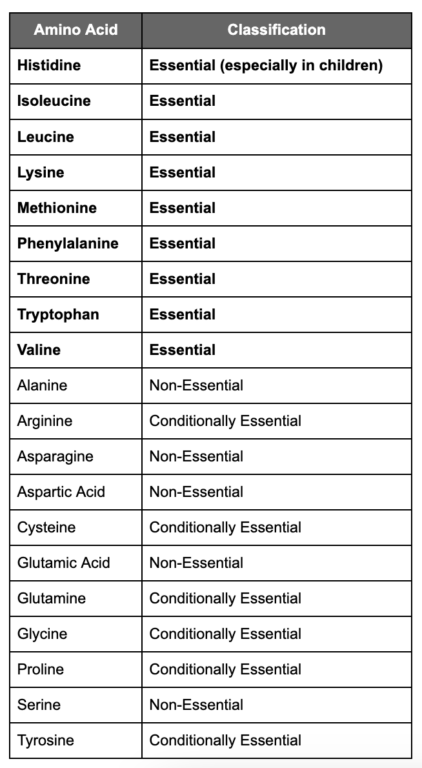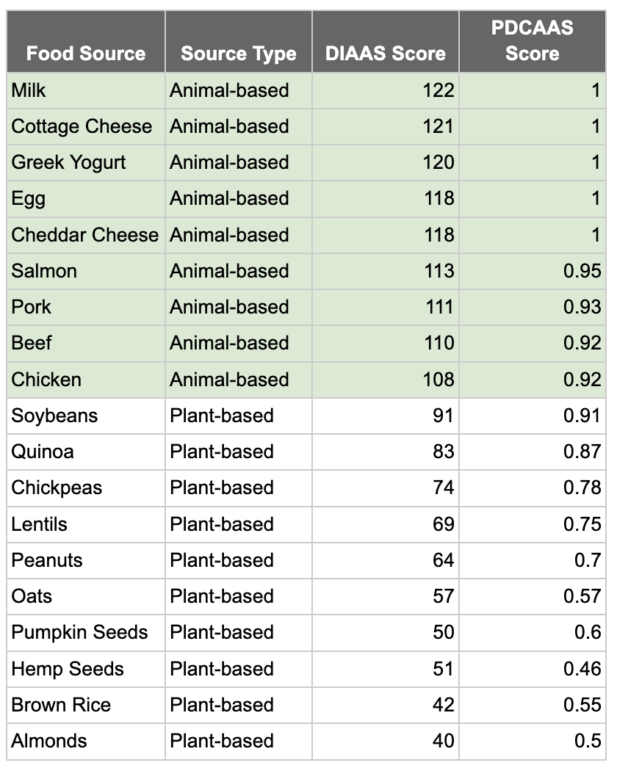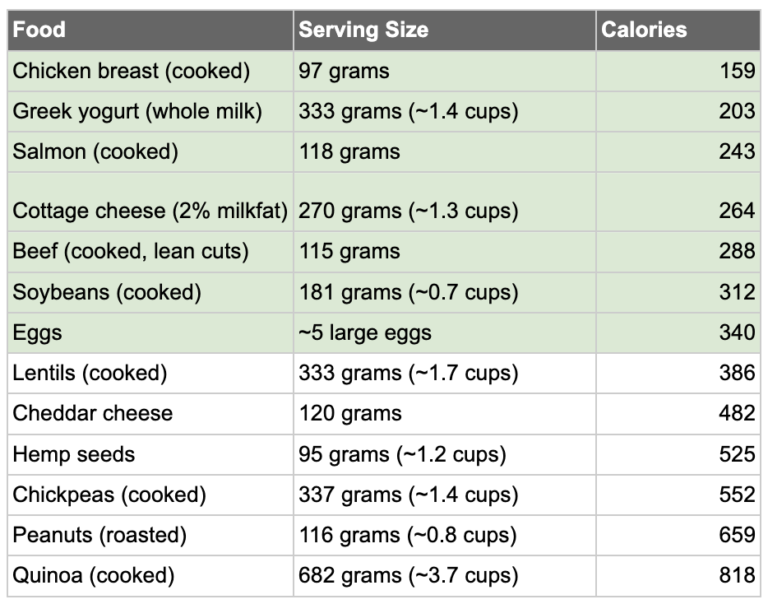The Macronutrients
There are three macronutrients, so named because they are the largest — “macro” — molecules. They are protein, carbohydrate, and fat. In the next three posts, we’ll do a deep dive into each one.
First up is protein.
Protein
Protein is the structural and functional foundation of the human body. Unlike carbohydrates and fat, which are primarily used for energy, protein is used to build, repair, and regulate nearly every system in the body. Your muscles, bones, skin, organs, hair, enzymes, immune cells, and even neurotransmitters are made from proteins. These proteins are assembled from smaller building blocks called amino acids — molecules that link together in specific sequences to form the vast array of proteins your body requires.
When you eat protein-rich foods, your digestive system breaks the protein down into its constituent amino acids, which are then absorbed and reassembled into the exact proteins your body needs in the moment — whether that’s repairing muscle tissue after a workout, forming strong bones, building antibodies to fight off infection, or making enzymes to support digestion.
Amino Acids: The Building Blocks of Life

Amino acids are small molecules made mostly of carbon, hydrogen, oxygen, and nitrogen. Each has a nitrogen-based amine group on one end and an acid group (called a carboxyl) on the other. This unique structure lets them link together in various ways to form proteins. Think of amino acids like Lego blocks and proteins as the near-infinite number of creations we can construct out of them.
There are 20 amino acids used to build proteins in the human body, nine of which are essential (meaning we have to get them from the diet), and another six that can become essential depending on factors such as training volume, illness, injury, etc. From these amino acids, the body produces at least 20,000 proteins that we know of. Some are small, such as the hormone insulin, constructed of just 51 amino acids linked together. Other proteins are huge. Titin, found in the sarcomere of muscle, is the largest protein in the body and is composed of approximately 34,350 amino acids.
Liebig’s Law
Protein synthesis in the body depends on the availability of all essential amino acids. The entire process slows or stops if even one is missing or inadequate. Liebig’s Law of the Minimum best explains this. Imagine a wooden barrel of staves, each representing a different essential amino acid. The barrel can only hold as much water as the shortest stave allows. Likewise, your body can only build proteins to the extent that all required amino acids are available in adequate amounts. If one is lacking, the others go to waste.


Protein Deficiency
Severe protein deficiency is rare in developed countries, but in extreme cases it can lead to kwashiorkor (characterized by swelling, fatty liver, and muscle wasting) or marasmus (a wasting condition caused by an overall deficiency in calories and protein). While most people aren’t at risk of these severe conditions, a chronic lack of adequate protein, known as subclinical protein deficiency, is surprisingly common. This is especially true for older adults, plant-based eaters, and active individuals who fail to meet the elevated protein demands of training and recovery.
Symptoms of insufficient protein intake may include persistent muscle soreness, slow recovery from workouts, fatigue, brittle hair and nails, weakened immune function, weak bones (osteoporosis or osteopenia), gradual loss of lean body mass, sleep disturbances, or mental health problems. Over time, low protein availability can impair performance, delay recovery, and increase injury risk.
Dietary Sources and Protein Quality
Protein is found in animal and plant foods, but not all sources are created equal. Animal-based foods such as meat, poultry, fish, eggs, and dairy contain all nine essential amino acids in the correct ratios and are considered “complete” proteins. Most plant-based sources, such as legumes, grains, nuts, and seeds, are considered “incomplete,” meaning they lack or are very low in one or more essential amino acids.
In addition to amino acid content, the bioavailability of a protein — how well it’s digested, absorbed, and used by the body — also matters. Animal-based proteins have higher bioavailability, meaning your body can access and use more of their amino acids. On the other hand, many plant proteins are wrapped in fiber and other compounds that make them harder to break down and absorb, lowering their overall effectiveness for building and repairing tissues.

Researchers have developed scoring systems to evaluate protein quality to account for these differences. The Protein Digestibility-Corrected Amino Acid Score (PDCAAS) has been widely used for years. It measures how well a protein meets essential amino acid needs and adjusts for digestibility. More recently, the Digestible Indispensable Amino Acid Score (DIAAS) has emerged as a more accurate system, measuring the digestibility of individual amino acids in the small intestine rather than crude nitrogen absorption. While PDCAAS is capped at 1.0 and tends to overestimate the value of some plant proteins, DIAAS provides a clearer picture of how much of a food’s protein is truly usable by the body. Animal proteins consistently score highest on both scales, reflecting their high digestibility and complete amino acid profiles. In contrast, plant proteins score lower due to lower digestibility and limiting amino acids, most commonly lysine or methionine.
For optimal health, recovery, and performance, we want to choose protein sources from the green zone on this chart (DIAAS above 100).
Protein Requirements and Athletic Performance
 The body is a nonstop machine, constantly breaking down and remodeling tissues, synthesizing hormones, producing enzymes, creating immune antibodies, and generating neurotransmitters. The need for amino acids is never-ending, yet we cannot store individual amino acids. The body requires a consistent, frequent supply of dietary protein to maintain all these essential functions.
The body is a nonstop machine, constantly breaking down and remodeling tissues, synthesizing hormones, producing enzymes, creating immune antibodies, and generating neurotransmitters. The need for amino acids is never-ending, yet we cannot store individual amino acids. The body requires a consistent, frequent supply of dietary protein to maintain all these essential functions.
For physically active individuals, especially those doing high-intensity training like CrossFit, protein needs are significantly higher than the standard government recommendations. While the Recommended Dietary Allowance (RDA) for protein is just 0.8 grams per kilogram of body weight per day (barely enough to prevent deficiency), athletes typically require between 1.6 and 2.2 grams per kilogram per day to support muscle repair, recovery, immune function, and performance.
Protein requirements may be even higher in older individuals, in a calorie deficit, training at high volume, or looking to preserve lean mass during weight loss. Timing also matters: distributing protein intake evenly across meals and including a protein-rich meal post-workout can support muscle protein synthesis and improve recovery outcomes. Each meal should contain a minimum of 30 grams of protein. This chart shows the serving size of each food to provide 30 grams of protein, sorted by total calories. Those in the green zone provide 30 grams of protein for 350 calories or less.
Do you want to know even more about protein? Read this series on protein here.
About the Author
 Jocelyn Rylee (CF-L4) and her husband David founded CrossFit BRIO in 2008, starting in a modest 1500 sq ft space and focusing on personal training. Her dedication to excellence has also earned her a position on CrossFit LLC’s Level 1 Seminar Staff, a role that allows her to share her passion and expertise with aspiring coaches. Jocelyn holds specialties in Endurance, Gymnastics, Competition, and Weightlifting and is also a certified Strength and Conditioning Specialist through the NSCA. As a Level 2 Olympic Weightlifting Coach and a Level 3 referee, she has been deeply involved in the sport, even serving as a board member of the Saskatchewan Weightlifting Association for five years. Her achievements include being Saskatchewan’s top-ranked female Olympic Weightlifter from 2012 to 2015, during which she held provincial records in the Snatch, Clean & Jerk, and Total in her weight class. With an MS in Human Nutrition, Jocelyn loves sharing her knowledge on nutrition and performance through her blog and Instagram as “The Keto Athlete,” where she delves into the science of nutrition and its impact on athletic performance.
Jocelyn Rylee (CF-L4) and her husband David founded CrossFit BRIO in 2008, starting in a modest 1500 sq ft space and focusing on personal training. Her dedication to excellence has also earned her a position on CrossFit LLC’s Level 1 Seminar Staff, a role that allows her to share her passion and expertise with aspiring coaches. Jocelyn holds specialties in Endurance, Gymnastics, Competition, and Weightlifting and is also a certified Strength and Conditioning Specialist through the NSCA. As a Level 2 Olympic Weightlifting Coach and a Level 3 referee, she has been deeply involved in the sport, even serving as a board member of the Saskatchewan Weightlifting Association for five years. Her achievements include being Saskatchewan’s top-ranked female Olympic Weightlifter from 2012 to 2015, during which she held provincial records in the Snatch, Clean & Jerk, and Total in her weight class. With an MS in Human Nutrition, Jocelyn loves sharing her knowledge on nutrition and performance through her blog and Instagram as “The Keto Athlete,” where she delves into the science of nutrition and its impact on athletic performance.